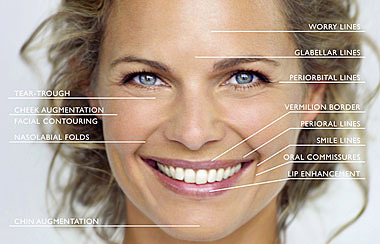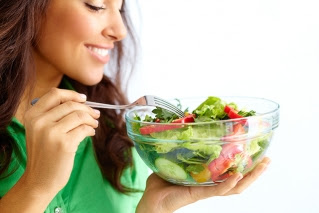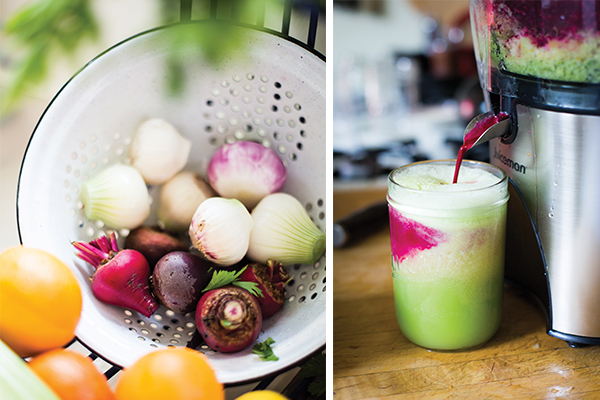
Experiencing sugar cravings, fatigue or an unwanted sloth-like feeling? This one day detox plan was designed to support all of your elimination organs, with a special emphases on liver supporting foods.
Your liver is responsible for doing a large portion of the work when it comes to detoxing your body. By eating foods that help it do its job, you will be facilitating healthy and effective toxin removal.
It is important to rest and nourish yourself while you are detoxing, even if it is just for one day. Take extra time to sleep, read, meditate, do restorative yoga, take a bath or any other activities that feel like nourishment for you. The more you rest and allow your body to heal, the more effective this little detox will be.
Super Green Detox Menu:
Upon Rising: Lemon Basil Vitamin Water
Breakfast: Super Greens Smoothie
Lunch: Love Your Liver Green Salad
Snack: Clean and Green Juice
Dinner: Lentil and Cauliflower Detox Soup
Before Bed: Herbal Tea
Super Green Detox Recipes:

Lemon Basil Vitamin Water
- 1 litre fresh water
- 1 lemon, sliced
- 5 basil leaves
- pinch Himalayan salt
Instructions: Place your lemon slices, basil leaves and Himalayan salt in your water and allow to sit for 1-12 hours. It can be nice to make this the night before your cleanse to have waiting for you in the fridge when you wake up. The longer you let it sit, the more potent the drink will be.
Why It Works:
- Water: will help to re-hydrate your system after being dehydrated over night.
- Lemon: will kickstart the activity of your liver as well as help to stimulate the emptying of your colon.
- Basil: is a powerful anti-inflammatory herb that will work to help cool and soothe your system which is very important for cleansing and detoxifying.
- Himalayan salt: has all 84 essential trace minerals the body needs to thrive, and it will help to alkalize your body.

Green Super Smoothie
- 1 cup fresh or frozen blueberries
- 1 cup red leaf lettuce
- 2 ribs celery
- 1/3 cup parsley
- 1/3 cup cilantro
- 1 lemon, peeled
- 1 inch piece ginger
- 1 cup water
Instructions: Place all ingredients in a high-speed blender and blend until smooth.
Why It Works:
- Berries: will provide essential antioxidants that are crucial to help protect your liver during detox. They are also rich in fibre which will help to cleanse your colon.
- Red Leaf Lettuce: is a slightly bitter green which will stimulate bile production helping to cleanse and clear the liver and gallbladder.
- Celery: will alkalize your system and provide your body with alkaline minerals.
- Parsley: is going to be supporting your kidneys.
- Cilantro: will help to pull heavy metals from your system.
- Lemon: will boost your liver function and the ginger will help to cleanse and clear your whole digestive tract.

Love Your Liver Green Salad
- 2 cups arugula
- 1 cup romaine lettuce
- 1 small beet, grated
- 1 large avocado, pit removed and sliced
- 1 lime, juiced
- option to add oil free balsamic and 2 tbsp. sauerkraut if you wish
Instructions: Place all ingredients in a bowl, toss and enjoy!
Why It Works:
- Arugula and romaine lettuce: will both alkalize your system, help to cleanse and clear your colon as well as providing that bitter taste to help stimulate your liver and gallbladder.
- Beet: is rich in beta-carotene and bioflavonoids, which are essential nutrients for liver detox.
- Avocado: is a precursor for glutathione, which is used in phase two liver detox. It is also rich in other amino acids which are all needed for effective liver detoxification.
- Lime: acts much like lemon in its liver cleansing action.

Clean and Green Juice
- 1/2 green apple
- 3 ribs celery
- 1/2 field cucumber
- 1/3 cup cilantro
- 1/3 cup parsley
- 1 lemon, peeled
- 1 inch piece ginger
Instructions: Run all ingredients through a juicer and enjoy!
Why It Works:
- Apples: are rich in b vitamins which help to support the digestive system and the metabolism.
- Celery: is rich in trace minerals which help to dilate blood vessels, supporting the transportation of wastes from your cells to your liver for removal.
- Cucumber: Cucumber is a super high water content fruit that will help to flush toxins from your system.
- Cilantro: will pull mercury from your body, which is a known neurotoxin
- Parsley: this awesome herb is a bitter green, meaning it will boost bile flow and help cleanse the liver
- Lemon: rich in vitamin C, this fruit will help your body fight any infection it may be dealing with.
- Ginger: is a powerful antibacterial food helping to defend your body from pathogens.

Lentil and Cauliflower Detox Soup:
- 1/2 cup dried lentils
- 1/2 head cauliflower, chopped
- half-inch piece fresh turmeric root, minced fine (or use 1/4 tsp dried)
- 2 cups water
- 1 tsp cumin powder
- 1 tsp paprika
- 1/2 tsp onion powder
- 1/2 tsp garlic powder or 1 garlic clove
- 1 tbsp apple cider vinegar
Instructions: Place your lentils, cauliflower, turmeric root water and spices in a pot and bring to a boil. Allow to cook for 15-20 minutes or until your lentils are tender. Remove from the heat. Add your apple cider vinegar. Enjoy!
Why It Works:
- Lentils: will provide your body will the needed amino acids so that it can detox properly.
- Cauliflower: is a cruciferous vegetable which means it is rich in sulfur compounds. These compounds are amazing for protecting the body from cancer as well as aiding in efficient liver detox.
- Turmeric root: contains a compound called curcumin which helps to slow down phase one liver detox, and stimulate phase two. This is a good thing because for most people phase two liver detox can be sluggish and this can lead to poor detoxification.
- The apple cider vinegar: will help to cleanse your whole system including your liver, gallbladder and digestive system.

Herbal Tea - Your choice:
- Chamomile
- Liquorice
- Lavender
- Passion Flower
- Valerian Root
- Lemon Balm
Instructions: Steep your tea in 1 cup of hot water and sip slowly before bed.
Why It Works: All of the above herbs have individual health benefits, though the one thing they all have in common is they are nourishing and replenishing to the adrenals and promote calm and relaxation. The reason we recommend them is because they are all calming and soothing for the nervous system and will help you to fall asleep and rest well.
Shopping lists:
Veggies
- 2 cups arugula
- 1 avocado
- 1 small beet
- 1 head cauliflower
- 5 ribs celery
- 1 field cucumber
- 1 cup red leaf lettuce
- 1 cup romaine lettuce
Fruits
- 1 green apple
- 1 cup fresh or frozen blueberries
- 3 lemon
- 1 lime
Fresh Herbs
- 5 basil leaves
- 1 bunch cilantro
- 2 inch piece ginger
- 1 bunch parsley
- 1 inch piece fresh turmeric root (or use 1/4 tsp dried)
Dried Herbs
- 1 tsp cumin powder
- 1 tsp paprika
- 1/2 tsp onion powder
- 1/2 tsp garlic powder
Nuts/Seeds/Legumes
Grocery
- 1 tbsp apple cider vinegar
- pinch Himalayan salt
- Herbal tea of choice
Ali is the Resident Holistic Nutritionist for Young and Raw. She came to the natural health field when she was 14, as a way of healing chronic stomach aches, skin issues, weight problems and hormonal imbalances. Years of doctors visits, specialist appointments and conventional medicine had never yielded results, so she tried looking for a natural solution. Going vegan in 2007, and 100% raw shortly after that, she was able to heal her body, and was inspired to share what had helped her so much with others.

















 Carrots - Take a cue from Bugs Bunny and eat LOTS of carrots as they are brilliant for building healthy skin and hair. Packed with carotene which turns into vitamin A for cell repair. They are also a good source of potassium, vitamins C & B6, copper, folic acid, thiamine, magnesium, and fiber. That means they heal, act as a diuretic (aka get rid of bloating), and remineralize the body. The perfect food for hair, eyes, and skin.
Carrots - Take a cue from Bugs Bunny and eat LOTS of carrots as they are brilliant for building healthy skin and hair. Packed with carotene which turns into vitamin A for cell repair. They are also a good source of potassium, vitamins C & B6, copper, folic acid, thiamine, magnesium, and fiber. That means they heal, act as a diuretic (aka get rid of bloating), and remineralize the body. The perfect food for hair, eyes, and skin.




